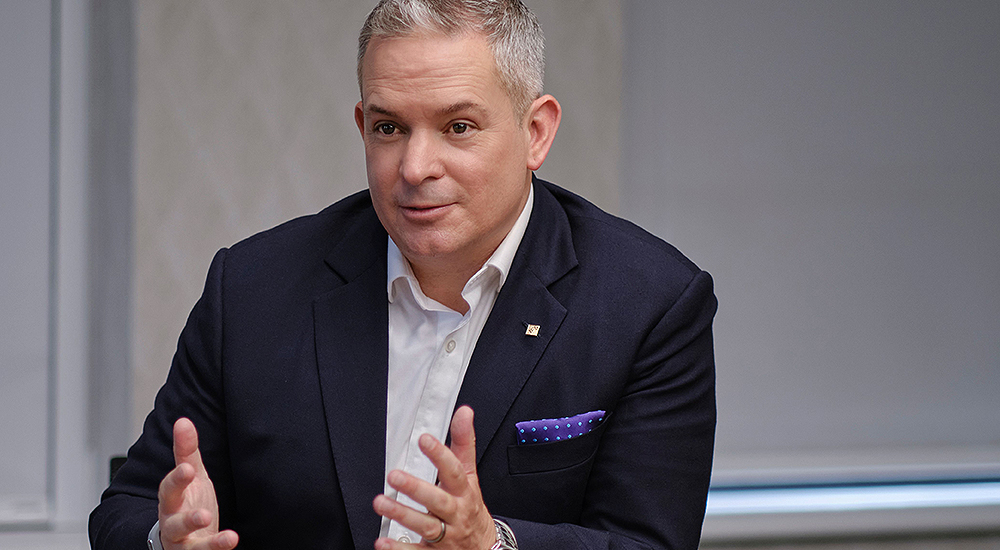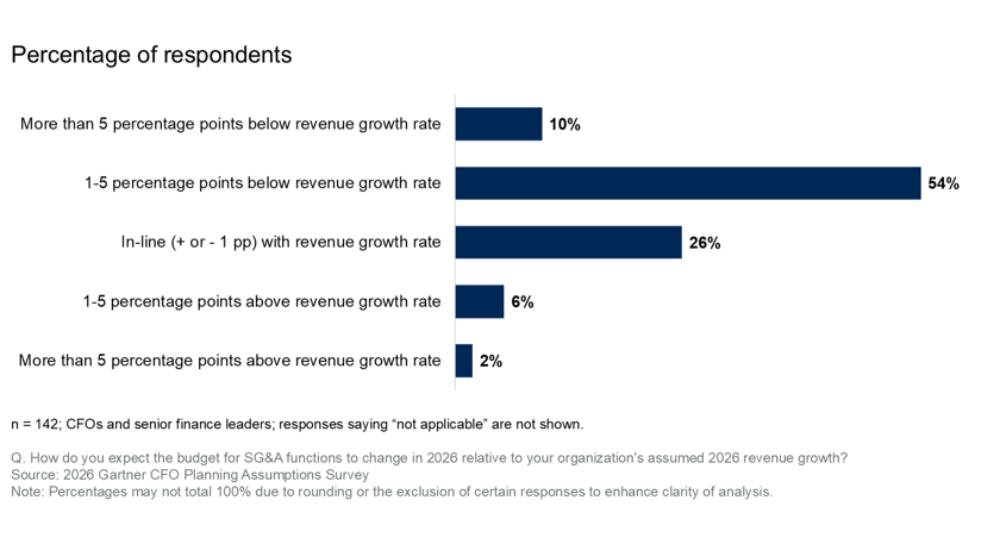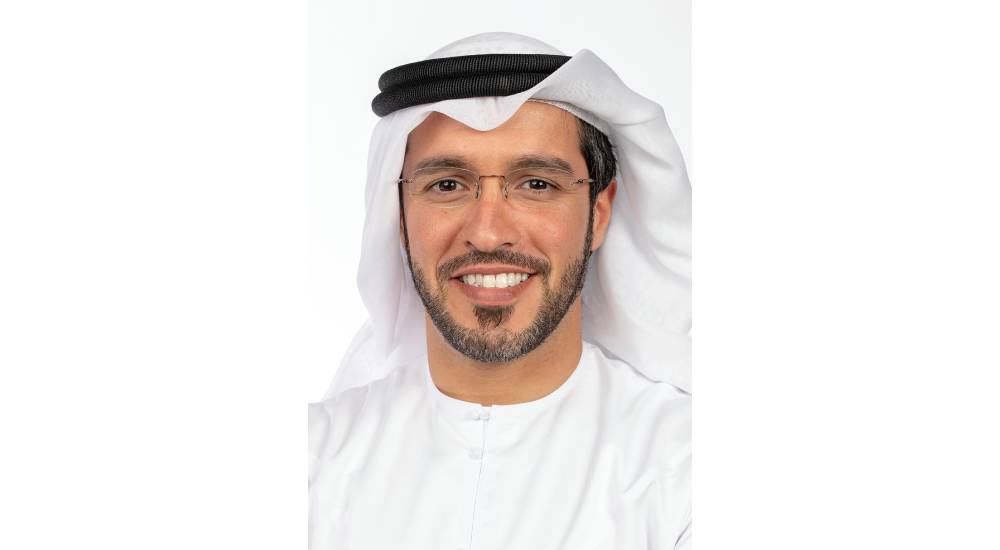In March this year, IFS, the near billion-dollar global enterprise applications vendor, released a new brand identity to announce its evolved market position. IFS rebranded itself and launched IFS Cloud. IFS Cloud is the most significant launch in the company’s history and sets a benchmark for the global enterprise application industry.
The new IFS branding was deployed across all touchpoints, including digital platforms, print and digital marketing, collaterals, merchandise, and office interiors. The roll-out was also accompanied by out-of-home advertising on some of the world’s most iconic activation sites including Times Square in New York, Burj Khalifa in Dubai, and Shibuya in Japan.
“I do not think anyone who looked at the old logo felt like it was a modern logo. It has been around for decades and our business has changed,” explains Darren Roos, CEO IFS. “We have changed from being an ERP and asset management vendor into delivering services for our customers,” he points out.
IFS decided to have the launch event coinciding with its rebranding and announcement of the IFS Cloud. More than that it was also an announcement of IFS taking a new position as a vendor in the enterprise solutions and services market place.
Customer feedback
The rebuilding and reengineering of IFS started three years ago, when Roos joined in 2018. From the beginning he actively engaged and sought feedback from end customers on the challenges they faced with technology solutions and the application of technology into their business. Over time the feedback fell into a pattern of consistent pain points for end users and sluggishness from the IT industry to make amends.
“The feedback was consistent. Customers were really struggling with the complexity that the technology industry were creating,” says Roos.
Enterprises had moved from mission critical applications and server-based hosting into a complex and fragmented world built around migration to the cloud. “They had no plan and they had this multitude of applications and they were really struggling with complexity,” continues Roos.
Some of their challenges were how do you secure all of these disparate applications; how do you manage the release cycles of all of these applications; how do you manage the complexity of integration of all these different applications, and others.
Another conclusive feedback that Roos received was that the IT industry was making it more and more difficult for end users rather than making it easier.
End customer were struggling with the orchestration of their customers, assets and employees, to drive their business, customer loyalty, share of wallet and profitability. End customers are not really concerned about application integration and release cycles and would much rather focus on driving value, and this sentiment has developed over time.
“At a fundamental level, none of that made any sense to customers,” points out Roos.
The takeaway for Roos, was that end users were looking for an environment that was simpler, easier to manage, easy to use, with a lower total cost of ownership, to orchestrate assets, people, and customers. If IFS could do that, it would be a solution that everybody would want and IFS would win more often.
“And that is what we have built,” reflects Roos. IFS has now spent more on software engineering from 2018 to 2020 than it has in the past years building the IFS Cloud.
“We sat about leveraging the assets that we had, made some acquisitions, and we did a truckload of engineering. And today, we have a single solution. We have taken away all of the complexity, that very fragmented landscape,” he explains.
IFS Cloud has been built for customers in service centric industries. It has the next generation capability of augmented reality, artificial intelligence, low code, robotic process automation, augmented reality. These components have been natively built into the solution and the customer does not have to go and buy them additionally. It is available on-premises or in the cloud.
Late mover advantage
Contrary to text-book management principles, being a late mover has actually helped IFS. As a late mover in the cloud go-to-market, coming up from behind has actually helped it to avoid the development and release pitfalls that other early mover ERP vendors have had to go through in the past. Moreover, by starting as late as 2018, has helped IFS to use the latest software tools to build its IFS Cloud solution stack.
“I think we had an advantage, which, frankly, a lot of the others did not have, which was – the when, we did it. The technology landscape has changed so much in the last few years, that if we had undertaken this, maybe five years ago, or ten years ago, the only option to achieve, a scalable, elastic, flexible cloud environment would have been to rewrite it. You would have had to completely rewrite the stack,” elaborates Roos.
As a late mover, and taking advantage of the latest cloud development tools including containerisation, automation, Kubernetes, hyper scalar hosting platforms, has made it easier to build an effective cloud solution.
“This is technology that just was not around before,” he stresses.
While development of the user interface was a lot of work, Roos indicates that the element of risk was fairly low, due to the advanced level of development tools available to build the IFS Cloud solution.
Makings of IFS Cloud
To begin its journey, IFS has built IFS Cloud entirely on the Microsoft Azure hyper scalar platform. Roos points out that the decision to use only one platform was based on not stretching limited resources across other platforms, including AWS.
IFS has gone all in with Microsoft Azure and is taking advantage of the various native capabilities that are available on Azure including Power BI, Power Apps, native automation. It is working closely with Jason Zander, Microsoft’s Executive Vice President and the Azure team and leveraging the capabilities available on Azure. “Microsoft has been a great partner to us,” reflect Roos.
Has IFS lost out on customers who would have preferred the availability of other hyper scalar platforms as well, including AWS? Roos does not think so. “I have not known one customer say to us, we are not going to go with IFS because you are not on AWS. It is just not the way it works.”
Potential customers for IFS Cloud are not taking decisions based on the hyper scalar platform that it is using. They are interested in the capability they are getting.
“Because we are all-in on Azure, we get the benefits of being able to leverage all of that capability on the Azure stack. And frankly if we were on AWS, we could do the same. But it is very difficult to do it across both, because you have finite resources,” rounds up Roos.
Another aspect that IFS has managed carefully is the refresh cycle of its updates. Do it too fast and end users will be in a continuous cycle of operational disruption. Do it too slow and end users will lag behind in their innovation cycle. Hence a fine balance is required.
The three key areas in the core of IFS Cloud including Enterprise Resource Planning, ERP; Enterprise Asset Management, EAM; and Field Service Management, FSM; are still complex and large applications. These need to be updated to keep end customers at the edge and yet not be overly disruptive.
Roos feels that customers should not be waiting for years to receive the latest innovations and by the same token customers do not want updates every month. Hence, IFS has chosen to follow a biannual cycle of refreshes for IFS Cloud, once every six months.

Core and periphery architecture
Another important feedback from end customers that has been used by Roos while building IFS Cloud is how the various components of IFS Cloud need to work with each other. IFS Cloud has a core built around ERP, EAM, and FSM.
“We are so focused on having a single application, a single platform, single database, single UX, single data model – but does everything have to be in that model,” he asks. “We have realised very recently, when it comes to the big applications ERP, EAM, FSM, it has got to be in that core.”
But as IFS adds on applications either as built or bought, into IFS Cloud, it will need to decide whether to add on the new additions into the core or to deploy them on as stand-alone, on the periphery. If they are intrinsically part of the IFS Cloud process then they would reside in the core, and not be deployed as stand-alone and on their own.
“There are certainly capabilities that I can think of that makes sense for them to be in the core,” says Roos.
On the other hand, there are capabilities that can be implemented quickly and have standalone use cases, and it may not make sense for them to be deployed inside the core of IFS Cloud.
Moving forward, any new bolt-on into IFS Cloud, whether in the core or on the periphery, will always follow the singular principle of deep integration. This is a guiding approach based on consistent feedback voiced by customers, whereby such new additions should not feel like a new product.
Roos wants to avoid a situation where IFS’ customers start getting, for example, a suite of technologies that have no harmonisation, the user experience and business processes make no sense, and the release cycles are out of sync.
“There must be a very clear relationship between the core and the peripheral application. If we are building, we will design with that imperative in mind. And if we acquire the very first thing we will do is focus on deep integration,” he explains.
All this is possible because IFS Cloud is using a framework of Restful APIs to connect existing and new components, across the core and the periphery.
Reducing technology debt
End users also complain about their growing technology debt created by software application vendors as they release upgrades and higher versions for their flagship products. Enterprise application vendors that have a large installed base, find their community of end users on multiple levels of upgrade and multiple versions over the years. And often, the end users find that there is no way forward for them.
Roos points out that this happens with end users of legacy ERP vendor applications. “There is the technology debt that any software vendor has got. The installed base of customers is on versions that do not necessarily transition or allow the customer to transition. There is no technical upgrade path for them to the latest version on those platforms.”
With the launch of IFS Cloud, this has been a key consideration as well. “That was particularly important for us. We did not want to leave customers behind.”
Another type of technology debt that is created by enterprise application vendors is when products do not work and interoperate with each other. “Every single customer I talked to is thinking about how they rationalise their estate,” Roos indicates.
Amongst the feedback that Roos has heard are comments like: I have too many applications and they do not work together; my users do not have a good experience, help me to rationalise the estate; how do I get rid of some of the applications that makes it easier to secure my environment; how do I make integration and the release cycles easier; amongst others.
Roos believes the IFS Cloud as it has been launched will help to reduce the technology debt of end customers, with its core and peripheral application architecture, and deep integration using the API framework.
IFS has also designed an upgrade path for its end user community to move from on-premises to the cloud. “We have put an immense amount of thought into it. And there is no reason why we cannot take them to IFS cloud in a few months.”
Roos also feels that the real challenge is not so much technology and process as it is a mind shift. “You are going from building server farms and having to stand up applications and manage those applications to really being the recipient of somebody else’s service.”
Moments of service
Technology vendors often believe that end users are looking out to buy technology. However what end users are really looking for is to solve their business problems. “No executive, I have ever spoken to has said what I really want now, is to buy an ERP solution,” points out Roos.
The technology piece is the easy piece and that is not a problem. And what is a problem is really understanding what end users are trying to achieve. As a typical example, often times at the end of a technology project, there is no definitive answer about whether any value has been created for its end users.
“Every technology company thinks their technology is the center of the universe,” according to Roos. “And that is fundamentally flawed.” Technology is never the center of the universe for the end user. The customer experience, and the moments of service for the end user’s customer is the center of the universe for the end user.
“We are explicitly trying to come at this from a non-technology perspective,” Roos points out. By helping to orchestrate assets, people and customers, through IFS Cloud, IFS is helping its end users deliver their moments of service for their customers.
“With the moment of service, what we are helping them to do is to frame that problem in the perspective of their customer. So, what is the moment of service that you are trying to create for your customer.” However, Roos also feels many of them have not thought about their business in that context.
“If the company can understand what the moment of service is, and then orchestrate assets, customers and people to deliver an outstanding moment of service, that is when the magic happens,” feels Roos.
“There is no question that companies that are able to do that will win more often, they will get more repeat business, and they will be more profitable,” he feels.
At the end of it all, there can be many approaches to the end goal. “What does matter is where you focus and the focus has got to be the moments of service,” reflects Roos.

Key takeaways
- Customers were really struggling with complexity the technology industry were creating.
- IT industry was making it more and more difficult for end users rather than making it easier.
- End customer were struggling with orchestration of customers, assets and employees, to drive business.
- End customers are not really concerned about application integration and release cycles and would focus on driving value.
- IFS has now spent more on software engineering from 2018 to 2020 than it has in the past years building the IFS Cloud.
- IFS Cloud has taken away complexity and fragmented landscape.
- IFS Cloud has been built for customers in service centric industries.
- IFS has gone all in with Microsoft Azure and is taking advantage of native capabilities.
- Potential customers for IFS Cloud are not taking decisions based on the hyper scalar platform that it is using.
- The three key areas in the core of IFS Cloud include ERP, EAM, FSM.
- IFS has chosen to follow a biannual cycle of refreshes for IFS Cloud, once every six months.
- IFS Cloud is using a framework of Restful APIs to connect existing and new components, across the core and the periphery.
- Every technology company thinks their technology is the center of the universe.
- Customer experience, and the moments of service for the end user’s customer is the center of the universe for the end user.
- By helping to orchestrate assets, people and customers, through IFS Cloud, IFS is helping its end users deliver their moments of service.




